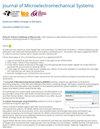用于纳米牛顿细胞牵引力传感的压阻微柱传感器
IF 2.5
3区 工程技术
Q2 ENGINEERING, ELECTRICAL & ELECTRONIC
引用次数: 0
摘要
多项研究表明,细胞产生的生物力的巨大变化是人体疾病的有力指标。为了充分发挥单细胞生物力学特性作为基于细胞的疾病诊断中的无标记、非侵入性生物标记的潜力,我们需要高通量测试平台,既能单独检测单细胞,又能同时测量成千上万个细胞。本研究提出了一种压阻式次$\mu \text{N}$横向力传感方法,使用垂直支柱作为结构元件,并在支柱下方嵌入硅基 N 型压阻器进行应力传感。对所开发的第一代传感器进行的实验测试表明,该传感器具有出色的 $\text{F}_{\mathrm {x}}$ 感应分辨率,最低可达 $\sim $ 70 nN。具有不同支柱几何形状的设备的测量灵敏度范围从 $\Delta \text{R}$ /R = 0.05% 到 0.14% $\mu \text{N}^{-1}$,并且可以通过简单地调整支柱几何形状来改变。虽然该传感器的分辨率与现有的 MEMS 平面传感器相当,但其设计却有别于现有的方法,它采用了基于三维打印支柱的方法,并与传统的纳米加工相结合,从而实现了 500 nm 至 3 \ mu \ text{m}$ 宽度的基底内压敏电阻。该器件在基底上的有效占位面积仅为几毫米,这使得传感器设计非常适合在两个平面轴上都具有几毫米传感器间距的大型密集传感阵列中实施。[2023-0190]本文章由计算机程序翻译,如有差异,请以英文原文为准。
Piezoresistive Micropillar Sensors for Nano-Newton Cell Traction Force Sensing
Several studies demonstrate that large variations in biologically cell-generated forces are strong indicators of diseases in the body. To realize the full potential of single-cell biomechanical properties as label-free, non-invasive biomarkers in cell-based disease diagnoses, we need high-throughput test platforms that interrogate single cells individually while allowing measurement of thousands of cells at a time. This work presents a piezoresistive sub-
$\mu \text{N}$
lateral force sensing approach using vertical pillars as structural elements and silicon-based, N-type piezoresistors embedded underneath the pillars for stress-sensing. Experimental testing of the first generation of sensors developed shows excellent
$\text{F}_{\mathrm {x}}$
sensing resolution down to
$\sim $
70 nN. Measured sensitivities of devices with different pillar geometries range from
$\Delta \text{R}$
/R = 0.05% to 0.14%
$\mu \text{N}^{-1}$
and are varied by simply scaling pillar geometry. While having a comparable resolution to existing MEMS in-plane sensors, the sensor design sets itself apart from existing approaches with its 3D printed pillar-based approach, which is combined with traditional nanofabrication to achieve 500 nm to
$3 \, \mu \text{m}$
width, in-substrate piezoresistors. Effective device footprint is a compact few
$\mu \text{m}^{2}$
on substrate which makes the sensor design ideal for implementation in large, dense sensing arrays with
$\mu \text{m}$
-scale sensor-to-sensor pitches in both in-plane axes. [2023-0190]
求助全文
通过发布文献求助,成功后即可免费获取论文全文。
去求助
来源期刊

Journal of Microelectromechanical Systems
工程技术-工程:电子与电气
CiteScore
6.20
自引率
7.40%
发文量
115
审稿时长
7.5 months
期刊介绍:
The topics of interest include, but are not limited to: devices ranging in size from microns to millimeters, IC-compatible fabrication techniques, other fabrication techniques, measurement of micro phenomena, theoretical results, new materials and designs, micro actuators, micro robots, micro batteries, bearings, wear, reliability, electrical interconnections, micro telemanipulation, and standards appropriate to MEMS. Application examples and application oriented devices in fluidics, optics, bio-medical engineering, etc., are also of central interest.
 求助内容:
求助内容: 应助结果提醒方式:
应助结果提醒方式:


